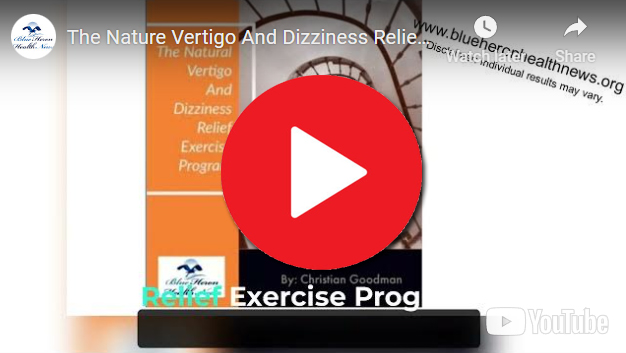
The Nature Vertigo And Dizziness Relief Exercise Program™ By Christian Goodman if you are suffering Vertigo and Dizziness and you are looking for natural solution, then Vertigo and Dizziness Program is here to help you. It will show you very simple but effective exercises that will stop this condition once and fall all. You will start to see positive results immediately when you start following the recommended head exercises and within days, this condition will be a thing of the past. This program is also very affordable and comes with 60 days 100% money back guarantee.
What is vertigo?
Vertigo is a symptom characterized by a sensation of spinning, dizziness, or feeling off-balance, often described as a feeling that either you or your surroundings are moving or spinning when they are not. Vertigo is typically caused by problems in the inner ear or the brain that affect the body’s sense of balance and spatial orientation.
Key Characteristics of Vertigo:
- Spinning Sensation: Vertigo is commonly associated with the feeling that you or your surroundings are spinning or tilting, even when stationary.
- Dizziness and Imbalance: People with vertigo often feel dizzy and unsteady, which can lead to difficulties walking, standing, or moving.
- Nausea and Vomiting: Vertigo can cause feelings of nausea and, in some cases, vomiting due to the disturbance in balance.
- Eye Movements (Nystagmus): In some cases, vertigo may be accompanied by involuntary eye movements known as nystagmus, where the eyes move rapidly from side to side.
Causes of Vertigo:
- Benign Paroxysmal Positional Vertigo (BPPV):
- Description: BPPV is the most common cause of vertigo and is triggered by changes in head position. It occurs when tiny calcium crystals (otoconia) become dislodged from their normal location in the inner ear and move into the semicircular canals, disrupting balance.
- Symptoms: Brief episodes of vertigo triggered by head movements, such as turning in bed, looking up, or bending over.
- Meniere’s Disease:
- Description: Meniere’s disease is a disorder of the inner ear characterized by episodes of vertigo, hearing loss, tinnitus (ringing in the ears), and a feeling of fullness in the ear. It is thought to be caused by an abnormal buildup of fluid in the inner ear.
- Symptoms: Sudden episodes of vertigo lasting minutes to hours, often accompanied by fluctuating hearing loss and tinnitus.
- Vestibular Neuritis or Labyrinthitis:
- Description: Vestibular neuritis is an inflammation of the vestibular nerve in the inner ear, often caused by a viral infection. Labyrinthitis also involves inflammation of the labyrinth (inner ear structures) and may affect hearing as well.
- Symptoms: Sudden onset of vertigo, often accompanied by nausea, vomiting, and, in the case of labyrinthitis, hearing loss.
- Migrainous Vertigo (Vestibular Migraine):
- Description: Migraine-related vertigo occurs in people with a history of migraines. It can cause episodes of vertigo, with or without headache, and may be triggered by the same factors that cause migraines, such as stress, certain foods, or bright lights.
- Symptoms: Vertigo episodes lasting minutes to hours, often accompanied by sensitivity to light and sound, and sometimes by migraine headaches.
- Other Causes:
- Stroke or Transient Ischemic Attack (TIA): Vertigo can be a symptom of a stroke or TIA, particularly when associated with other neurological symptoms such as weakness, slurred speech, or double vision.
- Head or Neck Injury: Trauma to the head or neck can affect the vestibular system and lead to vertigo.
- Vestibular Schwannoma (Acoustic Neuroma): This is a benign tumor that grows on the vestibular nerve, which can cause vertigo, hearing loss, and tinnitus.
Diagnosis and Treatment:
- Diagnosis: Diagnosis of vertigo is based on a physical examination, medical history, and specific tests to assess balance and eye movements. Imaging studies (such as MRI or CT scans) may be used if a central cause (such as a stroke or tumor) is suspected.
- Treatment: Treatment depends on the underlying cause of vertigo. Common treatments include:
- BPPV: The Epley maneuver or other positional exercises are used to reposition the calcium crystals in the inner ear.
- Meniere’s Disease: Treatment may involve dietary changes (such as reducing salt intake), medications to reduce fluid buildup, or, in severe cases, surgical interventions.
- Vestibular Neuritis/Labyrinthitis: Treatment includes anti-inflammatory medications, antivirals, and vestibular rehabilitation exercises.
- Migrainous Vertigo: Migraine management, including medications and lifestyle modifications, is key to controlling vertigo episodes.
Conclusion:
Vertigo is a symptom, not a condition itself, and is often linked to problems in the inner ear or the brain. It can cause dizziness, nausea, and a sensation of spinning, and it significantly impacts balance and quality of life. Identifying the underlying cause is essential for effective treatment and management.

The Nature Vertigo And Dizziness Relief Exercise Program™ By Christian Goodman if you are suffering Vertigo and Dizziness and you are looking for natural solution, then Vertigo and Dizziness Program is here to help you. It will show you very simple but effective exercises that will stop this condition once and fall all. You will start to see positive results immediately when you start following the recommended head exercises and within days, this condition will be a thing of the past. This program is also very affordable and comes with 60 days 100% money back guarantee.